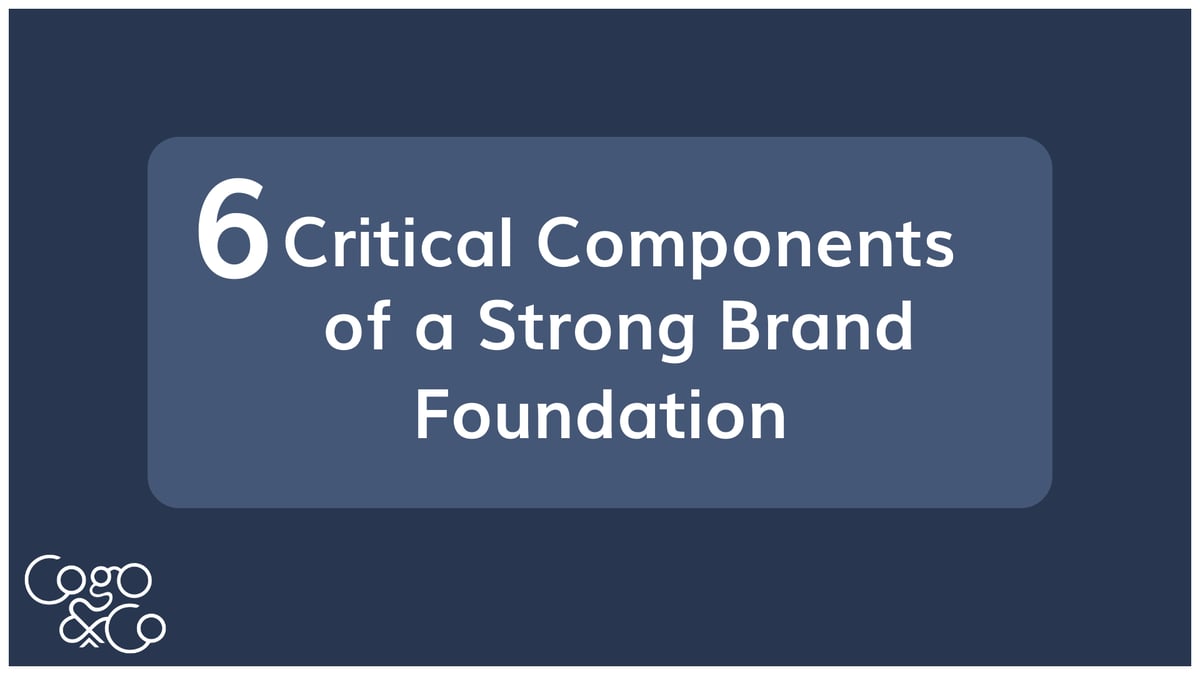
Your company’s image is its brand, and so the brand becomes the embodiment of the features and benefits of the company itself. To lay a strong foundation communicating your company’s value proposition internally and externally, you must ensure your brand foundation is solidly in place. In fact, according to Forbes, consistent brand presentation across all platforms increases revenue by up to 23%. By defining the key elements supporting your brand you can ensure your brand is well-positioned from others in the market.
1. Brand Identity:
Your brand identity demonstrates who your company is, defines positioning, and creates a competitive advantage. Brand elements include your name, tagline, logo, and design. Just as importantly, your brand identity includes your company’s personality and its assets, which include: brand awareness, emotional connection, credibility, and purchase motivation. Altogether, your brand is the key to unifying behaviors, actions, and communications. Each of these components of brand identity plays a strong role in communicating competitive advantages, product/services quality, competitive advantages, and operational efficiencies. A strong brand identity: resonates with all stakeholders, guides marketing, enables your sales force to sell more, and provides vision to your employees.
2. Brand Management:
Ensuring that your brand reflects the very best of your company requires planning support strategies. Strategies that support and build the brand include promotions, marketing, advertising, outreach, social media, and thought leadership. Additionally, brand management requires educating and training of internal personnel to ensure alignment of key messages delivered externally. By constantly monitoring and measuring brand awareness, as well as customer perceptions and loyalty, you can ensure that your brand is resonating with your target audience.
3. Brand Experience:
When people see your logo, read your tagline, or think about your company, the way they feel will be influenced by brand experience. A brand’s experience for customers is built through a wide variety of methodologies. The best methods for your brand are dependent on your target market and how you can best appeal to them. Certainly, every company’s brand experience relies on the public perceptions, products & services themselves, as well as personal interactions with the company (which underscores why internal education is so important).

4. Brand Strategy:
A strong brand strategy is the process of pinpointing your brand’s strongest attributes and integrating them into a unique value proposition. Brand strategy delivers on the VALUE the company has to offer its customers. Robust strategies include tactics for communicating brand promise with supporting messages that act as proof points. The creative elements and copy tone reinforce key messages, and give your brand depth and personality. The brand strategy clarifies how positioning in the market as well as the relationship with customers. For example, some business models call for high touch customer interactions while others do not. Your brand is at the heart of your overall business strategy, and requires in-depth understanding of your customer preferences and your competitors positioning. By deploying the brand strategy across the company, you successfully bring your unique value proposition to market.
5. Communicate Differentiation:
Your value proposition is unique, and for the best return on investment, you’ll want to ensure your clients understand exactly how you differentiate your company from all the others. To create your company’s unique value proposition, you’ll want to develop a clear statement which captures the unique value your company, products, and services bring to your customers.
Robust and unique Value Propositions focus on differentiation. Focus on the critical dimension of value where your company’s products and services excel. By drawing attention to your unique qualities, you will become the best choice for customers who need the unique advantages your company brings.
A solid, unique Value Proposition answers the question of why a customer should do business with your company and not someone else. Your Value Proposition statement hones in on the key reasons customers and prospects will buy the company’s services and products. By appealing to the customer’s strongest decision-making drivers with an authentic value-add, you are able to represent your brand and your Value Proposition in a way that gains the right attention from your target market.
Success depends on your ability to live up to the promise made through your company’s unique Value Proposition. Done correctly, your Value Proposition will focus strategies and tactics to increase revenues and market share.
6. Defining Your Value Proposition:
Identify the unique value-add facets of your offering and the advantages that result from this value. Create a statement that is clear and concise. Your statement should be specific and developed with key target audiences in mind. Ensure that in each step of the development process you FOCUS ON THE CUSTOMER, and evaluate all forms of advantages you bring to your customers including: predictive value drivers (i.e. quality), image, price, convenience, safety, and time.
Be prepared to review, refine, rewrite, and rework your Value Proposition until it is well aligned with your overall brand identity. You’ll want to find the words and talking points that resonate with your audience, and then stick with them – consistency drives results. It’s not creative to make the same statement multiple ways. It’s confusing. Once you develop your unique Value Proposition and the narrative that supports it, stick to it!
Recognizing Signs of a Weak Brand Foundation
Cutting through industry clutter is essential when it comes to maximizing performance.
Signs of a Weak Foundation
It's crucial to understand how to recognize a weak brand foundation. This can allow you to eliminate issues before they get out of control. Listed below are some of the most notable scenarios in which you need to take action.
Recognizing Signs of a Weak Brand Foundation
Cutting through industry clutter is essential when it comes to maximizing performance.
Signs of a Weak Foundation
It's crucial to understand how to recognize a weak brand foundation. This can allow you to eliminate issues before they get out of control. Listed below are some of the most notable scenarios in which you need to take action.
Reactive Marketing
Your marketing projects should be proactive and not reactive. This type of marketing is a sign of a poor brand foundation, and it often involves reinventing your brand numerous times in a short period. Not only can this lead to poor marketing metrics, but it can also confuse your target audience. There might even be situations where repeat customers feel like they interact with a different company each time. This could easily cause your audience to work with other brands.
Misplaced Values
Core values should never be neglected or compromised. If your teams don't adhere to these, you run the risk of diminishing your brand's integrity. Consumers will notice this, and they will grow to distrust your company over time. For example, let's assume that your business openly prides itself on minimizing its carbon footprint. If your practices tell a different story, this could erode your brand's foundation. Consider this when moving forward, as it's one of the most important brand marketing tips to keep in mind.
No Brand Alignment
Every component of your brand should align. This includes your marketing collateral, your leadership, etc. If brand alignment at your company seems disjointed, you'll likely encounter issues in the future. It's best to hold consistent meetings about your company's brand so you can ensure everything goes smoothly. Having regular insight into brand alignment will keep your branding cohesive throughout each customer interaction.
Too Much Emphasis on Products
When you place too much emphasis on marketing your products, you remove the soul from your brand. It also makes your consumers feel disposable. People love to purchase new things, but nobody likes to feel like they're being sold something. Instead, you should place an emphasis on your brand's personality and core values. Help people understand why they should choose you over a competitor. Show them how much your company cares about their loyalty. This can be a costly situation if left unmanaged. Not only will you lose prospective customers, but your competitors will gain them.
Skewed Perception
In some cases, the way you view your brand may be much different than how your audience sees you.
By addressing these signs of a weak brand foundation, you can strengthen your brand identity, enhance brand management efforts, improve brand experience, refine brand strategy, communicate differentiation effectively, and solidify your unique value proposition. This comprehensive approach will ensure that your brand stands out and resonates with your target audience, leading to increased success and market share.
Reactive Marketing
Your marketing projects should be proactive and not reactive. This type of marketing is a sign of a poor brand foundation, and it often involves reinventing your brand numerous times in a short period. Not only can this lead to poor marketing metrics, but it can also confuse your target audience. There might even be situations where repeat customers feel like they interact with a different company each time. This could easily cause your audience to work with other brands.
Misplaced Values
Core values should never be neglected or compromised. If your teams don't adhere to these, you run the risk of diminishing your brand's integrity. Consumers will notice this, and they will grow to distrust your company over time. For example, let's assume that your business openly prides itself on minimizing its carbon footprint. If your practices tell a different story, this could erode your brand's foundation. Consider this when moving forward, as it's one of the most important brand marketing tips to keep in mind.
No Brand Alignment
Every component of your brand should align. This includes your marketing collateral, your leadership, etc. If brand alignment at your company seems disjointed, you'll likely encounter issues in the future. It's best to hold consistent meetings about your company's brand so you can ensure everything goes smoothly. Having regular insight into brand alignment will keep your branding cohesive throughout each customer interaction.
Too Much Emphasis on Products
When you place too much emphasis on marketing your products, you remove the soul from your brand. It also makes your consumers feel disposable. People love to purchase new things, but nobody likes to feel like they're being sold something. Instead, you should place an emphasis on your brand's personality and core values. Help people understand why they should choose you over a competitor. Show them how much your company cares about their loyalty. This can be a costly situation if left unmanaged. Not only will you lose prospective customers, but your competitors will gain them.
Skewed Perception
In some cases, the way you view your brand may be much different than how your audience sees you. This discrepancy could cause your branding messages to fall flat. It might also influence the way you view your target audience and cause you to make poor marketing decisions in the future. Building a strong brand doesn't have to be difficult, but it's essential to maintain a realistic view of your company. This will help keep you on the right track and provide a better customer experience.

